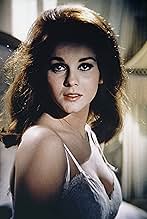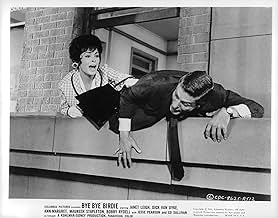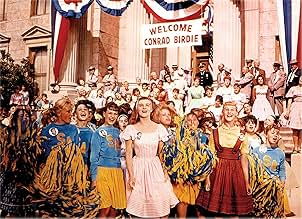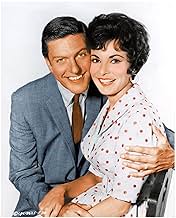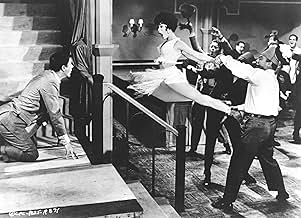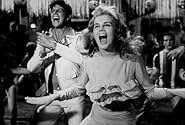AVALIAÇÃO DA IMDb
6,6/10
9,8 mil
SUA AVALIAÇÃO
Adicionar um enredo no seu idiomaA rock singer travels to a small Ohio town to make his "farewell" television performance and kiss his biggest fan before he is drafted.A rock singer travels to a small Ohio town to make his "farewell" television performance and kiss his biggest fan before he is drafted.A rock singer travels to a small Ohio town to make his "farewell" television performance and kiss his biggest fan before he is drafted.
- Direção
- Roteiristas
- Artistas
- Indicado a 2 Oscars
- 7 indicações no total
- Direção
- Roteiristas
- Elenco e equipe completos
- Produção, bilheteria e muito mais no IMDbPro
Avaliações em destaque
When 'Bye Bye Birdie' was the hit of the '59-'60 season on Broadway, it was as much for its satirical edge as for the talent on stage or the innovative direction by Gower Champion. By that time it was only too clear to savvy adults that Elvis Presley and rock'n'roll had been thoroughly co-opted and mainstreamed by Hollywood and Madison Avenue. For all its supposed danger and subversiveness in 1956, Rock was a pop culture commodity like any other by the end of the decade.
And by the time BYE BYE BIRDIE hit the screen in 1963, that point was too obvious to have any edge. Presley had long since become a bland and unfashionable movie personality, and rock itself had devolved into the kind of inconsequential June/Moon tunes that in a slightly different form had been hit parade staples for decades.
So the point is, the teen world BYE BYE BIRDIE was parodying was largely gone by that time already. Just a year later, when the Beatles appeared on Ed Sullivan (ironically he was still a King Maker but not for much longer) that world began to dissolve and reform unforgettably. So BIRDIE is the swan song for an era and an expression of Baby Boom nostalgia for kids who were too young to have enjoyed the '50s in quite the same way their older brothers and sisters had. How many children in '63 thrilled to the vigorous twitching of Ann-Margret and Bobby Rydell, hoping that was the teen world that awaited them in the future, only to discover by '68 that alienation and anger were the currency of the day? Not that those emotions were misplaced -- the times themselves demanded them. But there was a sense of loss too, a sense that we had been cheated out of fun: silly, twitchy dances and full skirts and snug pastel pullovers. There's a reason this film made an indelible impression on children then, and perhaps most on girls and gay boys.
It was an old-fashioned musical in a movie era that was confused but evolving rapidly, and Ann-Margret was a transitional star of that moment. A throwback to another Hollywood, she gets the traditional star buildup here, and it works spectacularly. Like Rita Hayworth in GILDA, A-M was the good/bad girl -- fresh and sweet and direct enough to please any elder, but with a smoldering animal eroticism so potent the screen seemed barely able to contain it. She is hot in the runway opening and delicious thereafter but she doesn't really become a star until a pivotal moment in the 'Got A Lot Of Livin' To Do' number when her eyes narrow, she smiles and grits her teeth and her hands envelope the head of a chorus boy while she parses out the lyrics of female sexual emancipation -- Daddy won't know his daughter indeed.
It was a sexual call to action that kids understood and responded to. So THIS was what being a teenager would be like! In that moment and the few minutes that followed, even gay boys felt the tops of their heads come off. It's an excitement that doesn't return until the coda: once again A-M is on the runway, but this time any pretense that she is sweet, innocent Kim McAfee has gone -- this is Ann-Margret, and the sexual light and heat of a new star is palpable. Unfortunately, she was almost immediately to become outdated. Within a few years she was a joke in pictures, and had to wait until 1971 and CARNAL KNOWLEDGE to make a 'comeback' -- at the age of 30, no less. She had made the mistake of starting too late, and being too traditional a Hollywood star just when Hollywood decided to do away with stars, at least those that were provokingly lovely.
So BIRDIE trembled on the edge of a new, harsher era, and those of us who were caught on the cusp of that upheaval feel great affection for the fantasy of rock stars like Birdie, for Sweet Apple High, and for the bouncy, shiny, crisp teenagers we never were.
And by the time BYE BYE BIRDIE hit the screen in 1963, that point was too obvious to have any edge. Presley had long since become a bland and unfashionable movie personality, and rock itself had devolved into the kind of inconsequential June/Moon tunes that in a slightly different form had been hit parade staples for decades.
So the point is, the teen world BYE BYE BIRDIE was parodying was largely gone by that time already. Just a year later, when the Beatles appeared on Ed Sullivan (ironically he was still a King Maker but not for much longer) that world began to dissolve and reform unforgettably. So BIRDIE is the swan song for an era and an expression of Baby Boom nostalgia for kids who were too young to have enjoyed the '50s in quite the same way their older brothers and sisters had. How many children in '63 thrilled to the vigorous twitching of Ann-Margret and Bobby Rydell, hoping that was the teen world that awaited them in the future, only to discover by '68 that alienation and anger were the currency of the day? Not that those emotions were misplaced -- the times themselves demanded them. But there was a sense of loss too, a sense that we had been cheated out of fun: silly, twitchy dances and full skirts and snug pastel pullovers. There's a reason this film made an indelible impression on children then, and perhaps most on girls and gay boys.
It was an old-fashioned musical in a movie era that was confused but evolving rapidly, and Ann-Margret was a transitional star of that moment. A throwback to another Hollywood, she gets the traditional star buildup here, and it works spectacularly. Like Rita Hayworth in GILDA, A-M was the good/bad girl -- fresh and sweet and direct enough to please any elder, but with a smoldering animal eroticism so potent the screen seemed barely able to contain it. She is hot in the runway opening and delicious thereafter but she doesn't really become a star until a pivotal moment in the 'Got A Lot Of Livin' To Do' number when her eyes narrow, she smiles and grits her teeth and her hands envelope the head of a chorus boy while she parses out the lyrics of female sexual emancipation -- Daddy won't know his daughter indeed.
It was a sexual call to action that kids understood and responded to. So THIS was what being a teenager would be like! In that moment and the few minutes that followed, even gay boys felt the tops of their heads come off. It's an excitement that doesn't return until the coda: once again A-M is on the runway, but this time any pretense that she is sweet, innocent Kim McAfee has gone -- this is Ann-Margret, and the sexual light and heat of a new star is palpable. Unfortunately, she was almost immediately to become outdated. Within a few years she was a joke in pictures, and had to wait until 1971 and CARNAL KNOWLEDGE to make a 'comeback' -- at the age of 30, no less. She had made the mistake of starting too late, and being too traditional a Hollywood star just when Hollywood decided to do away with stars, at least those that were provokingly lovely.
So BIRDIE trembled on the edge of a new, harsher era, and those of us who were caught on the cusp of that upheaval feel great affection for the fantasy of rock stars like Birdie, for Sweet Apple High, and for the bouncy, shiny, crisp teenagers we never were.
This musical, for those of us who were of the age then, represents a time and a place we thought would not end. Entering our early teens in suburbia, begat of young war veterans, the biggest issues in our lives were those reflected in this film; who pinned who and the adulation of our musical icons. The whole world was Sweet Apple and "someday we would find out this was what life was all about" as Kim sings to a befuddled Hugo. Even nerds could fall in love. And an equal force in our weekly lives was the Sunday ritual of The Ed Sullivan Show. This is a beautiful homage to that world that would end seven months later in Dallas and bring with it the counter culture, riots and Viet Nam. Hard to put on a happy face... But you will with this score. More fifties and Bosa Nova then the hip sixties it is toe tapping and gets under your skin. Worth repeat viewings. And as always "I gotta be sincere..if you feel it in here.." and I still do.
Bye Bye Birdie which ran a most respectable 607 performances on Broadway was the second musical by the team of Charles Strouse and Lee Adams. And though they've been responsible for such additional Broadway hits as Applause, Golden Boy, All American, not one other of their shows has ever been adapted to the screen.
Though Bye Bye Birdie contains a number of hit songs still performed frequently today, it's never been revived. Interesting in that Grease which was a satire of that pre-Beatles era of rock and roll is performed all the time. You'd think the real article would occasionally be revived.
The only ones who make the transition from Broadway to Hollywood from the cast are Dick Van Dyke and Paul Lynde. Probably because respectively they are so identified with the songs Put On A Happy Face and Kids that no one would see the film if they weren't in it.
Based on the great pop culture uproar when Elvis Presley got drafted, Bye Bye Birdie is about a contest thought up by production assistant Janet Leigh to the Ed Sullivan Show to help her struggling songwriter boyfriend Dick Van Dyke. He writes a song One Last Kiss and Janet puts the idea to Sullivan to have Conrad Birdie {Jesse Pearson) sing it on the show to a special Conrad Birdie fan selected at random and bestow one last kiss before Uncle Sam takes him.
The lucky girl is Ann-Margret of Sweet Apple, Ohio and wouldn't you know that she'd come from a town like that. The teen virgin roles Sandra Dee didn't get are the ones Ann-Margret got and unlike Dee, that girl could sing and dance. Her boyfriend is Bobby Rydell who was at the height of his teen idol popularity as well and they do make an attractive and charming couple.
The dynamic of the triangle of Birdie, boyfriend, and fan is a very big change from the Broadway show. Realize that Bobby Rydell's part was played on Broadway by Michael J. Pollard and you KNOW it has to be different. Rydell, Pearson, and Ann-Margret sing and dance A Lot of Living To Do.
Janet Leigh is not thought of as a musical performer, but she did acquit herself well, though she would never have classified herself in Chita Rivera's echelon as a dancer. Leigh was in Howard Hughes's earlier attempt at RKO for a big musical in Two Tickets to Broadway and she did well there as she does here.
To say Bye Bye Birdie is from a more innocent time is to belabor the obvious. But if Grease can be continually revived, why can't Bye Bye Birdie?
Though Bye Bye Birdie contains a number of hit songs still performed frequently today, it's never been revived. Interesting in that Grease which was a satire of that pre-Beatles era of rock and roll is performed all the time. You'd think the real article would occasionally be revived.
The only ones who make the transition from Broadway to Hollywood from the cast are Dick Van Dyke and Paul Lynde. Probably because respectively they are so identified with the songs Put On A Happy Face and Kids that no one would see the film if they weren't in it.
Based on the great pop culture uproar when Elvis Presley got drafted, Bye Bye Birdie is about a contest thought up by production assistant Janet Leigh to the Ed Sullivan Show to help her struggling songwriter boyfriend Dick Van Dyke. He writes a song One Last Kiss and Janet puts the idea to Sullivan to have Conrad Birdie {Jesse Pearson) sing it on the show to a special Conrad Birdie fan selected at random and bestow one last kiss before Uncle Sam takes him.
The lucky girl is Ann-Margret of Sweet Apple, Ohio and wouldn't you know that she'd come from a town like that. The teen virgin roles Sandra Dee didn't get are the ones Ann-Margret got and unlike Dee, that girl could sing and dance. Her boyfriend is Bobby Rydell who was at the height of his teen idol popularity as well and they do make an attractive and charming couple.
The dynamic of the triangle of Birdie, boyfriend, and fan is a very big change from the Broadway show. Realize that Bobby Rydell's part was played on Broadway by Michael J. Pollard and you KNOW it has to be different. Rydell, Pearson, and Ann-Margret sing and dance A Lot of Living To Do.
Janet Leigh is not thought of as a musical performer, but she did acquit herself well, though she would never have classified herself in Chita Rivera's echelon as a dancer. Leigh was in Howard Hughes's earlier attempt at RKO for a big musical in Two Tickets to Broadway and she did well there as she does here.
To say Bye Bye Birdie is from a more innocent time is to belabor the obvious. But if Grease can be continually revived, why can't Bye Bye Birdie?
I really mean it. On the surface, it appears to be a funny, innocent, slap-happy musical. And it is - at least during the first half of the movie. Then it starts to wink at itself. I was ten when I first saw it, and though I enjoyed it a lot of it went way over my head. Watching it now, ten years later, I realize that BYE BYE BIRDIE is actually a smart, sophisticated satire that's not for kids.
The title character is Conrad Birdie, a vain, oily rock-'n'-roll star who's been drafted by the army. In fact, the movie focuses not so much on him as it does on the other characters - a songwriter and producer (Dick Van Dyke), his girlfriend (Janet Leigh), and a teenage girl named Kim (Ann-Margret). Forget Jesse Pearson, who plays Conrad; it's Van Dyke and Margret's movie all the way.
As I said, this film is actually a satire. There are so many in-jokes and jabs at the 1960s that watching it is almost like reading an issue of MAD or CRACKED magazine. In particular, the Cold War comes in for some heavy ribbing (this movie was made during 1962, the year of the Cuban Missile Crisis); the Soviets are made to look like pompous buffoons, with one guy even whacking himself in the head with his shoe (hint, hint). It's still pretty funny nearly four decades later, but I can imagine how much more of a punch it would have packed back during those foreboding times. In other scenes, the movie predates the style of John Waters by poking some fun at suburbia.
Lots of satire - and most of it decisively adult. You can bet that kids simply won't understand the scathingly sarcastic remarks delivered by Kim's Archie Bunkeresque father (Paul Lynde), or Kim's budding sexuality. And of course they're not going to be familiar with Ed Sullivan (himself). Still, there are lots of joyfully kinetic dance numbers and memorable songs (most notably "Going Steady," "Got a Lot of Livin' To Do," and the tune everybody remembers: "Put on a Happy Face"). Kids will want to fast-forward the VCR to the musical numbers, and also the funniest moment in the picture, which involves a glass of drugged milk and a ballet conductor.
An excellent, well-made, highly underestimated comedy, and infinitely superior to the made-for-TV version from 1995. So get a bowl of popcorn and check out this classic piece of popular culture. Just be prepared to explain a lot to the kiddies...
The title character is Conrad Birdie, a vain, oily rock-'n'-roll star who's been drafted by the army. In fact, the movie focuses not so much on him as it does on the other characters - a songwriter and producer (Dick Van Dyke), his girlfriend (Janet Leigh), and a teenage girl named Kim (Ann-Margret). Forget Jesse Pearson, who plays Conrad; it's Van Dyke and Margret's movie all the way.
As I said, this film is actually a satire. There are so many in-jokes and jabs at the 1960s that watching it is almost like reading an issue of MAD or CRACKED magazine. In particular, the Cold War comes in for some heavy ribbing (this movie was made during 1962, the year of the Cuban Missile Crisis); the Soviets are made to look like pompous buffoons, with one guy even whacking himself in the head with his shoe (hint, hint). It's still pretty funny nearly four decades later, but I can imagine how much more of a punch it would have packed back during those foreboding times. In other scenes, the movie predates the style of John Waters by poking some fun at suburbia.
Lots of satire - and most of it decisively adult. You can bet that kids simply won't understand the scathingly sarcastic remarks delivered by Kim's Archie Bunkeresque father (Paul Lynde), or Kim's budding sexuality. And of course they're not going to be familiar with Ed Sullivan (himself). Still, there are lots of joyfully kinetic dance numbers and memorable songs (most notably "Going Steady," "Got a Lot of Livin' To Do," and the tune everybody remembers: "Put on a Happy Face"). Kids will want to fast-forward the VCR to the musical numbers, and also the funniest moment in the picture, which involves a glass of drugged milk and a ballet conductor.
An excellent, well-made, highly underestimated comedy, and infinitely superior to the made-for-TV version from 1995. So get a bowl of popcorn and check out this classic piece of popular culture. Just be prepared to explain a lot to the kiddies...
I am usually in the corner of those who complain about how Hollywood generally altered many classic Broadway stage musicals into something radically different when they were made into movies. Most of the time, the changes were ridiculous and weakened the property dramatically.
"Bye Bye Birdie" though, is the rare exception where the changes made to get it to the big screen were absolutely necessary. And nothing demonstrates this more than the fact that the faithful 1995 TV version is a lumbering, slow-moving mess that manages to demonstrate perfectly how what plays great on the stage does not always translate effectively to the film medium.
By contrast, the 1963 film version decided to make itself a bright, colorful film extravaganza that played to the strengths of the film medium. And the results in my opinion, worked wonderfully.
To a stage fan like "citybuilder" who rips the changes from the play, he needs to stop and think of how the structure of the stage version, which has the Sullivan show moment and the punching of Conrad as an Act I finale, would never have worked on film. It simply makes more cinematic sense to move that to the end. And the whole big deal over Rose's ethnicity, which was really done to showcase the talent of Broadway lead Chita Rivera, would have been a distraction as well because spotlighting Albert's mother as a racist would have gone against the whole tone of the movie (and truth be told "Spanish Rose" is not that great a song). Likewise, it's better to have Albert sing "Put On A Happy Face" to Rose rather than a nameless Conrad Birdie fan we never see again.
Dick Van Dyke and Paul Lynde offer the right amount of gravitas from the Broadway cast, Janet Leigh in her black wig gets to show off her dancing talent which she seldom got a chance to do (her singing is admittedly a bit thin, but she gets by), and of course Ann-Margret totally elevates the role of Kim McAfee into a star vehicle, and who can blame them for doing this? Her rendition of the title song written for the film is enough to leave one gasping for air, yet she still manages to be convincing as the wide-eyed teenager just the same.
Ultimately, stage fans can be satisfied that they got the version they prefer done on film (though it should be noted that the 95 version is not a pure rendition of the 1960 stage script, but rather the 1991 touring revival), but movie fans got the better end of things with this version in 1963. It will never be among the great movie musicals, but it is two solid hours of colorful early 60s fun.
"Bye Bye Birdie" though, is the rare exception where the changes made to get it to the big screen were absolutely necessary. And nothing demonstrates this more than the fact that the faithful 1995 TV version is a lumbering, slow-moving mess that manages to demonstrate perfectly how what plays great on the stage does not always translate effectively to the film medium.
By contrast, the 1963 film version decided to make itself a bright, colorful film extravaganza that played to the strengths of the film medium. And the results in my opinion, worked wonderfully.
To a stage fan like "citybuilder" who rips the changes from the play, he needs to stop and think of how the structure of the stage version, which has the Sullivan show moment and the punching of Conrad as an Act I finale, would never have worked on film. It simply makes more cinematic sense to move that to the end. And the whole big deal over Rose's ethnicity, which was really done to showcase the talent of Broadway lead Chita Rivera, would have been a distraction as well because spotlighting Albert's mother as a racist would have gone against the whole tone of the movie (and truth be told "Spanish Rose" is not that great a song). Likewise, it's better to have Albert sing "Put On A Happy Face" to Rose rather than a nameless Conrad Birdie fan we never see again.
Dick Van Dyke and Paul Lynde offer the right amount of gravitas from the Broadway cast, Janet Leigh in her black wig gets to show off her dancing talent which she seldom got a chance to do (her singing is admittedly a bit thin, but she gets by), and of course Ann-Margret totally elevates the role of Kim McAfee into a star vehicle, and who can blame them for doing this? Her rendition of the title song written for the film is enough to leave one gasping for air, yet she still manages to be convincing as the wide-eyed teenager just the same.
Ultimately, stage fans can be satisfied that they got the version they prefer done on film (though it should be noted that the 95 version is not a pure rendition of the 1960 stage script, but rather the 1991 touring revival), but movie fans got the better end of things with this version in 1963. It will never be among the great movie musicals, but it is two solid hours of colorful early 60s fun.
Você sabia?
- CuriosidadesIronically, Bobby Rydell, who plays the timid Hugo Peabody, was himself a national teen idol before and after the film's production. In fact, in contrast to the original stage musical where Michael J. Pollard played the role, the part of Hugo was expanded significantly in the film to accommodate his teen celebrity.
- Erros de gravaçãoAfter Rosie pulls the McAfee family out of the audience at Toast of the Town (1948), two different shots of the Russian conductor show the McAfees still sitting in the audience.
- Citações
Rose DeLeon: I must be the prized dope of all-time... thinking I could pry you away from your mama's ever-lovin' tentacles.
- Cenas durante ou pós-créditosThere is no "The End" credit or cast list at the end of the film. Ann-Margret simply sings an on-screen reprise of the song "Bye Bye Birdie" at the end, and then says " 'Bye, now!".
- ConexõesEdited into Histoire(s) du cinéma: Seul le cinéma (1994)
- Trilhas sonorasBye Bye Birdie
Music by Charles Strouse
Lyrics by Lee Adams
Performed by Ann-Margret before the title credits, with Johnny Green and the Columbia Studio Orchestra and Chorus
Reprised by Ann-Margret in the finale
Principais escolhas
Faça login para avaliar e ver a lista de recomendações personalizadas
- How long is Bye Bye Birdie?Fornecido pela Alexa
Detalhes
- Data de lançamento
- País de origem
- Idiomas
- Também conhecido como
- Adiós, ídolo mío
- Locações de filme
- Empresa de produção
- Consulte mais créditos da empresa na IMDbPro
Bilheteria
- Faturamento bruto nos EUA e Canadá
- US$ 13.129.412
- Tempo de duração1 hora 52 minutos
- Cor
- Proporção
- 2.35 : 1
Contribua para esta página
Sugerir uma alteração ou adicionar conteúdo ausente

Principal brecha
What is the Brazilian Portuguese language plot outline for Adeus, Amor (1963)?
Responda


